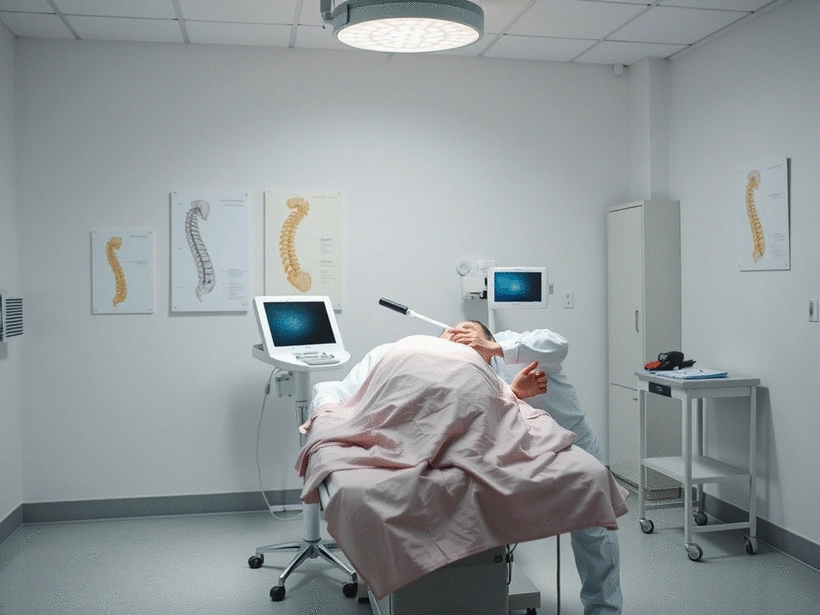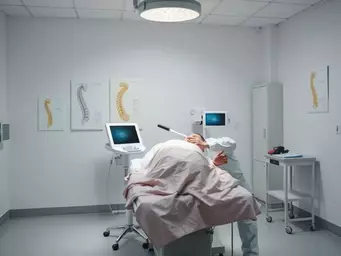Lumbar Puncture for MS Diagnosis

Have you ever wondered how medical professionals diagnose conditions like multiple sclerosis? The process involves several key tools, one of which is the lumbar puncture. This procedure can significantly inform diagnosis and treatment options for patients. Let's delve into what this means for you.
What You Will Learn
- The lumbar puncture is crucial for confirming multiple sclerosis (MS) by identifying specific markers in cerebrospinal fluid (CSF).
- Regular lumbar punctures enable monitoring of disease progression, enhancing treatment effectiveness.
- Analysis of CSF can reveal indicators like oligoclonal bands and elevated IgG, essential for distinguishing MS from other conditions.
- A comprehensive neurological examination complements lumbar punctures, providing a holistic view of a patient's health.
The Lumbar Puncture Process for MS Diagnosis
This diagram illustrates the key steps involved in a lumbar puncture (spinal tap) and the subsequent cerebrospinal fluid (CSF) analysis for diagnosing Multiple Sclerosis (MS).
1. Lumbar Puncture Procedure
A needle is inserted into the lower back to collect Cerebrospinal Fluid (CSF).
2. CSF Analysis
- • Oligoclonal Bands: Immune response
- • Elevated Immunoglobulin G (IgG): Inflammation
- • Cell Count & Proteins: Pathology
3. Neurological Exam
- • Reflexes: Nervous system function
- • Coordination & Balance: Motor control
- • Sensory Testing: Nerve damage
4. Diagnosis Confirmation
Combined insights from CSF and neurological examination confirm MS diagnosis and rule out other conditions.
Understanding the Role of Lumbar Puncture in Multiple Sclerosis Diagnosis
When it comes to diagnosing multiple sclerosis (MS), a lumbar puncture plays a pivotal role in providing crucial information. This procedure, often referred to as a spinal tap, allows us to collect cerebrospinal fluid (CSF), which can reveal important indicators of MS. By understanding how this process works, we can better navigate the complexities of MS diagnosis and management.

As a neurologist with over a decade of experience, I have seen firsthand how these insights can empower patients and their families. The lumbar puncture is not just a procedure; it’s a key step in confirming a diagnosis that can shape the course of treatment and care.
What is a Lumbar Puncture and Why is it Important for MS Diagnosis?
A lumbar puncture is a medical procedure that involves inserting a needle into the lower back to access the spinal canal and collect CSF. This fluid surrounds the brain and spinal cord, providing important clues about neurological health. For more detailed information on MS diagnosis, you can refer to resources from the Mayo Clinic.
- **Diagnosis Confirmation:** It helps confirm the presence of MS by identifying markers such as oligoclonal bands.
- **Exclusion of Other Conditions:** The analysis can rule out other diseases that may mimic MS symptoms.
- **Monitoring Disease Progression:** Regular lumbar punctures can help in tracking the progression of MS over time.
Understanding the importance of this procedure can help alleviate some of the anxiety surrounding it. It’s essential for patients to feel informed and prepared as they embark on their diagnostic journey.
Detecting Key Indicators: The Significance of Cerebrospinal Fluid Analysis
The analysis of cerebrospinal fluid obtained from a lumbar puncture can provide invaluable insights. In MS, we specifically look for certain indicators that can confirm the diagnosis, often alongside criteria like those outlined in the McDonald Criteria for MS diagnosis.
- Oligoclonal Bands: The presence of these bands in the CSF indicates an immune response in the central nervous system.
- Elevated Immunoglobulin G (IgG): High levels of IgG can suggest inflammation and help differentiate MS from other conditions.
- Cell Count and Proteins: Analyzing these components can reveal the underlying pathology associated with MS. For further scientific context, you can explore studies on biomarkers in MS, such as those discussed in PMC articles.
By closely examining these indicators, we can make more informed decisions about your treatment plan. It’s all about empowering you with knowledge to help you navigate your health journey!
Neurological Examination: Complementing the Lumbar Puncture in MS Diagnosis
A lumbar puncture is just one piece of the diagnostic puzzle. Complementing this procedure is a thorough neurological examination, which assesses various functions:
- Reflexes: Checking your reflexes helps us understand how well your nervous system is functioning.
- Coordination and Balance: Examining these can reveal any disruptions in motor control.
- Sensory Testing: Assessing sensitivity to touch, pain, and temperature can indicate nerve damage.
It’s important to approach your diagnosis holistically. While a lumbar puncture offers key insights, a comprehensive neurological examination ensures we leave no stone unturned. Together, these steps help us form a complete picture of your health and guide us toward the most effective management strategies.
Step-by-Step Overview of the Lumbar Puncture Procedure
In my practice at Symptoms of MS, I emphasize the importance of transparency and education regarding medical procedures. Understanding what to expect can ease any fears about the lumbar puncture process.
Pro Tip
Did you know? Preparing for a lumbar puncture can significantly ease your anxiety. Consider practicing relaxation techniques, such as deep breathing or visualization, prior to the procedure. Additionally, discussing your concerns with your healthcare provider can help clarify what to expect, making the experience less daunting.
Summarizing Key Insights on Lumbar Puncture in MS Diagnosis
As we wrap up our discussion on lumbar punctures in the context of multiple sclerosis diagnosis, it’s crucial to recognize both the benefits and limitations of this procedure. A lumbar puncture can provide valuable insights into cerebrospinal fluid (CSF) that might be indicative of MS. However, it’s not the sole diagnostic tool at our disposal, which is why understanding its role is essential.

Here are some key benefits of lumbar puncture:
- Helps to identify oligoclonal bands, which are essential markers for MS.
- Provides a clear assessment of the CSF’s chemical composition.
- Can rule out other conditions that may mimic MS symptoms.
However, as with any medical procedure, there are limitations. For instance, not all patients with MS will have positive results from a lumbar puncture, and some may experience discomfort during the procedure. It’s important to weigh these factors when considering this diagnostic option.
Frequently Asked Questions about Lumbar Puncture and MS Diagnosis
- Q: What is a lumbar puncture and how does it help diagnose MS?
- A: A lumbar puncture, or spinal tap, is a medical procedure where a needle is inserted into the lower back to collect cerebrospinal fluid (CSF). Analyzing this fluid helps diagnose MS by identifying markers like oligoclonal bands and elevated IgG, which indicate an immune response in the central nervous system.
- Q: What specific indicators in CSF suggest MS?
- A: Key indicators include the presence of oligoclonal bands, which show an immune response, and elevated levels of Immunoglobulin G (IgG), suggesting inflammation. Analysis of cell count and proteins can also reveal pathology associated with MS.
- Q: Is a lumbar puncture the only test required for an MS diagnosis?
- A: No, a lumbar puncture is one crucial tool, but it's not the sole diagnostic method. It is complemented by a thorough neurological examination, which assesses reflexes, coordination, balance, and sensory function, to provide a holistic view for diagnosis.
- Q: Can a lumbar puncture help monitor MS progression?
- A: Yes, regular lumbar punctures can help in tracking the progression of MS over time by analyzing changes in CSF composition, which can inform treatment effectiveness.
- Q: What are the potential limitations or drawbacks of a lumbar puncture?
- A: While beneficial, not all MS patients will have positive lumbar puncture results. Some patients may also experience discomfort during the procedure. These factors are considered when evaluating diagnostic options.
Next Steps: Preparing for Your Consultation and Making Informed Decisions
Now that you have a better understanding of lumbar punctures, it’s time to prepare for your consultation with your healthcare provider. Being informed is empowering! Here are some tips to ensure you get the most out of your discussion:
- Write down any symptoms you’ve been experiencing, including their frequency and duration.
- Prepare questions regarding the lumbar puncture procedure, its implications, and alternatives.
- Consider bringing a family member or friend for support and to help remember the information shared.
Having a clear list of concerns and questions will help facilitate a productive dialogue with your neurologist. Remember, your health journey is a collaborative process, and being proactive can lead to better outcomes!
Understanding the Role of Family Support and Patient Education
Living with MS can be challenging, but having a strong support network can make a significant difference. Family support plays a vital role in navigating the complexities of diagnosis and treatment. It’s essential for loved ones to be informed about MS symptoms and the diagnostic process, so they can provide the best possible support.
At Symptoms of MS, we encourage you to involve your family in your educational journey. Here’s how you can foster this support:
- Share resources from our platform to help your family understand MS.
- Discuss your symptoms openly with them, encouraging a space for questions and concerns.
- Engage in educational workshops or local support groups together.
Ultimately, empowering both yourself and your family with knowledge about multiple sclerosis can enhance your overall well-being and make the diagnostic journey a little less daunting. Remember, you’re not alone on this path!
Recap of Key Points
Here is a quick recap of the important points discussed in the article:
- A lumbar puncture is essential for confirming a multiple sclerosis (MS) diagnosis by identifying markers like oligoclonal bands.
- This procedure helps exclude other conditions that may mimic MS symptoms, ensuring accurate diagnosis.
- Regular analysis of cerebrospinal fluid (CSF) can monitor disease progression and inform treatment strategies.
- A thorough neurological examination complements the lumbar puncture, assessing reflexes, coordination, and sensory function.
- Preparation for consultations with healthcare providers, including noting symptoms and questions, enhances patient engagement and understanding.
- Involving family in the educational process about MS can significantly support the patient's journey through diagnosis and treatment.








